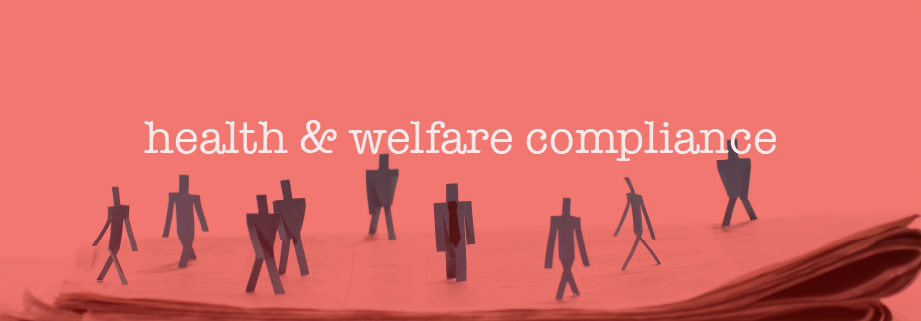Some employers may have to undergo a reduction in force (RIF) due to the economic conditions caused by the coronavirus. Since certain health and welfare compliance obligations are based on an employer’s headcount, a RIF may impact an employer’s plan responsibilities. Below, we outline how some health and welfare plan compliance obligations may be affected.
Affordable Care Act (ACA)
ACA Employer Mandate
General Rule: The ACA Employer Mandate requires Applicable Large Employers (ALEs) to offer affordable, minimum value healthcare coverage to their full-time employees and their dependents. ALEs are employers with 50 or more full-time (FT) and full-time equivalent (FTE) employees, on average, in the prior year.
Effect of a RIF: ALEs who have a RIF that causes them to drop below an average of 50 FT and FTE employees during 2020, will no longer be an ALE that is subject to the Employer Mandate in 2021.
Important Note: ALE status is based on the average number of FT and FTE employees in the entire calendar year. Therefore, an employer may continue to be an ALE after a RIF if it does not cause the employer to fall below a yearly average of 50 employees.
Example: Employer had an average of 100 FT and FTE employees from January through April 2020. Due to the economic downturn, Employer had a 60% RIF. From May 2020 through December 2020, Employer had an average of 40 FT and FTE employees.
Average FT and FTE employees (“EEs”) in 2020:
= (100 EEs x 4 months) + (40 EEs x 8 months) / 12 months
= 60 employees
Employer had an average of 60 FT and FTE employees in 2020. This means Employer will remain an ALE in 2021 and will still be subject to the Employer Mandate, even though they had a RIF that resulted in them dropping below 50 employees by the end of 2020.
ACA Reporting
General Rule: ALEs and all level funded/self-insured employers must complete annual ACA reporting to demonstrate that they complied with the ACA Employer Mandate. For each calendar year, ACA reporting is due in February (for paper filing) or March (for electronic filing) of the following year. As such, ACA reporting for the 2020 calendar year will be due in February/March of 2021.
Effect of a RIF: Employers who were ALEs in 2020 or who are level-funded/self-funded must still complete ACA reporting in 2021.
- ALE Employers in 2020: must complete ACA reporting in 2021, even if they are not ALEs in 2021. Employers who are not ALEs in 2021 will not have to complete ACA reporting in 2022.
Example: Employer had an average of 55 FT and FTE employees in 2019 and is an ALE in 2020. Since Employer is an ALE in 2020, they must complete ACA reporting for 2020, which is due in February/March of 2021.
Employer had a RIF in 2020 and dropped to an average of 45 FT and FTE employees by the end of 2020. Employer will not be an ALE subject to the Employer Mandate in 2021. Therefore, Employer will not be required to complete ACA reporting for 2021, which would have been due in February/March of 2022.
- Level-funded and self-insured employers: must complete ACA reporting no matter their employee headcount, so a RIF will not affect their reporting obligation.
Form W-2 Reporting
Cost of Healthcare Coverage
General Rule: Employers who issued more than 250 W-2s in the previous tax year must report the cost of healthcare (both the employee and employer portion) on employees’ W-2. Thus, if an employer issued more than 250 W-2s in 2019, they must report the cost of healthcare on their employees’ 2020 W-2s, which must be issued to employees by January 31, 2021.
Effect of a RIF: If employers do not issue 250 or more W-2s in 2020, then they will not be required to report the cost of healthcare coverage on their 2021 W-2s (which are due to employees by January 31, 2022). Nonetheless, many employers choose to voluntarily report the cost of healthcare coverage on employees’ W-2s, even if they are not required to do so.
HSA Contributions
All employers are required to report any employee and/or employer contributions to HSAs on employees’ W-2s. This requirement is not dependent on an employer’s headcount, so any RIF will not affect this obligation.
IRS Health and Welfare Form 5500 and Summary Annual Report
Health and Welfare Form 5500 (Form 5500)
General Rule: Employers who have health and welfare benefit plans with 100 or more participating employees (current employees and COBRA participants) on the first day of the plan year must submit a Form 5500 to the IRS.
Important Note for Wrapped Plans: If an employer’s health and welfare plans are “wrapped,” or combined, under a wrap Summary Plan Description (SPD), then they only need to file one Form 5500 for all of their wrapped plans (rather than filing a Form 5500 for each individual plan). This also means that an employer is required to file a Form 5500 (with information on all of their wrapped plans) if any one of their wrapped plans has more than 100 participants on the first day of the plan year, even if the other plans fall below the 100 participant count.
The Form 5500 is due on the last day of the 7th month following the end of the plan year (absent a request for a 2 ½ month extension). Accordingly, for plans that end on December 31, 2020, the Form 5500 will be due by July 31, 2021 (or October 15, 2021 with a 2 ½ month extension).
Effect of a RIF: Employers will have an obligation to file a Form 5500 based on the number of participating employees on the first day of the plan year. If this count was 100 participants or more, they will be required to file a Form 5500, even if that count drops below 100 during the year.
Summary Annual Report
General Rule: Employers who filed a Form 5500 are required to distribute a summary of the Form 5500, called the Summary Annual Report (SAR), to plan participants 9 months after the end of the plan year, or 2 months after due date of the Form 5500, if the employer filed an extension. Employers must provide the SAR to individuals who participated in the plan during the time period for which the Form 5500 was filed (which can include current employees, former employees, and COBRA participants).
Example: If a plan began on January 1, 2020 and ended on December 31, 2020, the Form 5500 would be due by July 31, 2021 (or October 15, 2021 with a 2 ½ month extension). Employers must distribute the SAR to plan participants by September 31, 2021 (or December 15, 2021 with an extension). Employers must distribute the SAR to individuals who participated in the plan from January 1, 2020 through December 31, 2020, even if they are no longer an employee or participant in the plan.
Effect of a RIF: Employers should keep in mind that they may be required to distribute a SAR to former employees. As such, it is best practice for employers to collect electronic disclosure consent forms during a RIF so they can send the SAR (or any other required disclosures) electronically, if necessary. Without this consent, employers must mail or hand deliver SARs to former employees to comply with the Department of Labor electronic disclosure rules.
COBRA Continuation Coverage
Federal COBRA
General Rule: Employers with 20 or more employees in the prior year are subject to federal COBRA. COBRA requires these employers to offer COBRA continuation coverage to employees and their covered dependents (collectively referred to as “COBRA qualified beneficiaries”) if they experience a COBRA qualifying event that causes them to lose employer-sponsored healthcare coverage. A termination in employment or a reduction in hours are two such qualifying events.
Employers must also send a COBRA election notice to qualified beneficiaries within 44 days of the COBRA qualifying event. Although most employers work with a vendor to administer COBRA benefits and send out the required notices, it is ultimately the employer’s responsibility.
Effect of a RIF: Employers undergoing a RIF should ensure that their employees who are terminated or who lose coverage due to a reduction in hours are given their COBRA election notice within the required time period. Employees who elect COBRA continuation coverage will be entitled to the same benefits, choices, and services as similarly situated active employees, including the right to open enrollment and the same coverage options.
In addition, employers will generally be required to provide the same health and welfare plan notices to COBRA participants during open enrollment and throughout the year, including the employer’s wrap SPD.
For more, see the DOL guide on COBRA Continuation Coverage.
State COBRA Benefits
In addition to federal COBRA, many states have their own COBRA-like laws, which also provide for healthcare continuation. Certain states, such as California and New York, impose requirements on employers who have 2 to 19 employees (who are not subject to federal COBRA) and these laws also provide for the extension of healthcare coverage for individuals who have exhausted any federal COBRA coverage. Each state’s COBRA-like laws are unique, and employers should reach out to their COBRA vendor or legal counsel to determine whether they have obligations under these state laws.
Conclusion
The above overview is not meant to provide an all-inclusive list of every compliance obligation that may be affected after a RIF. Nonetheless, this article is meant to serve as a reminder that employers may still have residual health and welfare plan reporting and compliance obligations even after dropping below certain employee headcount thresholds. Although an employer’s responsibilities may not change in the short-term, a RIF may alter their compliance obligations in the years to come.
It is important to emphasize that this article only reviews how a RIF impacts an employer’s health and welfare benefit plans. Employers are encouraged to speak with a legal counsel for any employment law questions related to a RIF.
The information and materials on this blog are provided for informational purposes only and are not intended to constitute legal or tax advice. Information provided in this blog may not reflect the most current legal developments and may vary by jurisdiction. The content on this blog is for general informational purposes only and does not apply to any particular facts or circumstances. The use of this blog does not in any way establish an attorney-client relationship, nor should any such relationship be implied, and the contents do not constitute legal or tax advice. If you require legal or tax advice, please consult with a licensed attorney or tax professional in your jurisdiction. The contributing authors expressly disclaim all liability to any persons or entities with respect to any action or inaction based on the contents of this blog.




